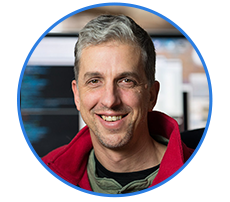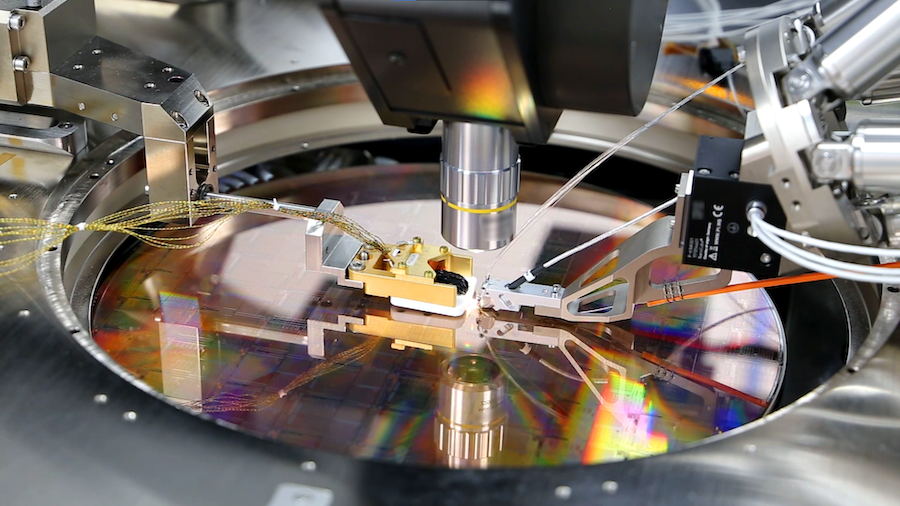Earlier this month D-Wave Systems, the quantum computing pioneer that has long championed quantum annealing-based quantum computing (and sometimes taken heat for that approach), announced it was expanding into gate-based quantum computing.
Surprised? Perhaps we shouldn’t be. Spun out of the University of British Columbia in 1999, D-Wave initially targeted gate-based quantum computing and discovered how hard it would be to develop. The company strategy morphed early on.

“I joined in 2005 when the company was first transitioning from a gate-model focus to quantum annealing focus,” recalled Mark Johnson, now vice president of quantum technologies and systems products. “There was still this picture that we wanted to find the most direct path to providing valuable quantum applications and we felt that quantum annealing was the was the way to do that. We felt the gate model was maybe 20 years away.”
That was then. Today, buoyed by its experience and success in building semiconductor-based superconducting qubits for annealing systems – notably its systems engineering and on-chip control circuitry expertise, according to Johnson – D-Wave seeks to enter the gate-based market. At its recent annual user meeting, Qubits (virtual), the company spelled out its plans under the banner of Clarity Roadmap.
Much of the roadmap is a continuation of D-Wave’s quantum annealing systems. While makers of gate-based quantum computers struggle to get to 100 qubits, D-Wave has a 5000-qubit system, with 15-way qubit interconnect technology, and is planning a 7000-qubit system. However, quantum annealing and gate-based systems are very different beasts. So-called universal gate-based system quantum computers of the kind being pursued by IBM, Rigetti, Google and others are more flexible and can handle wide range of applications They are the end game.
Quantum annealing systems, such as D-Wave’s Advantage system, have been shown they can solve select optimization problems very well, and in a more direct, less-complicated way than gate-based systems. D-Wave is hardly walking away from quantum annealing computing.
“There’s a growing body of theoretical work now highlighting the fact that quantum annealing is likely always going to be the best approach towards optimization and that’s not what I think we all thought five or ten years ago,” said Johnson, “That’s significant to us and we’ve seen that with a broad range of actually useful customer applications.” In this context, useful customer applications are really more proto-applications (logistics, biopharma, etc.) and no one is using them in production. Still, Johnson believes some apps will be in production in the 1-to-2-year timeframe.
Most of the news around D-Wave’s quantum annealing branch was covered in its press release, which HPCwire posted (D-Wave Details Product Expansion and Cross-Platform Roadmap.) Johnson’s briefing of HPCwire focused on D-Wave move into gate-based quantum computing: why do it now; considerations that drove sticking with superconducting qubit technology and not something else; and a walk-through D-Wave’s five-phase roadmap to develop gate-based systems.
“Let me say this. What we’re proposing to do is going to be hard, right, it’s going to be very hard. There are a lot of very strong competitors in that space. So it’s going to be challenging, but we think we think that our approach is really the strongest,” said Johnson.
So Why Now?
D-Wave contends its work building larger many-thousand-qubit quantum annealing systems has uniquely prepared it for tackling the scale-up problems bogging down gate-based quantum development. Most observers agree that cramming thousands (or millions) of cables into icy-cold dilution refrigerator to control qubits is impractical long-term, and there are many efforts (Intel and Microsoft are just two) to develop cryo-controller chips.
“It looks like we’re going to need hundreds of thousands of qubits and I don’t see how we can connect all the qubits to all the room temperature electronics [with cables]. The only practical, scalable way to develop a gate model system is with some kind of integrated fabrication stack. We think of superconducting-based qubits and a multilayer (3D), integrated circuit fabrication stack, that requires also a lot of investment and understanding of materials and understanding of how to improve coherence. This is exactly what we’re doing for quantum annealing,” said Johnson.
“When we started digging into it, there was a lot of overlap. Many of the problems were very similar. A lot of the technology that we had developed around on-chip integrated control circuitry – for example, the cold superconducting classical circuits necessary for doing things like homogenizing manufacturing variations across multiple qubits that allowed us to scalable IO so you don’t have several wires for every qubit. The ability to do this sort of de-multiplexed, efficient control of many, thousands or tens of thousands of devices with a just few hundred wires. All of that was necessary to integrate and develop quantum annealing on a [large] scale,” said Johnson.
He didn’t detail the techniques that D-Wave has developed for noise mitigation and signal control but D-Wave has fielded much larger quantum annealing-based systems than those of its gate-based rivals whose systems still hover around 50-60 qubits. Quantum annealing qubits and controls are very different from their gate-based system counterparts, but Johnson says the lessons learned by D-Wave are broadly applicable.
Why Not Ion Trap or Photonics?
It’s perhaps not surprising that D-Wave has chosen to bet on semiconductor-based superconducting qubit technology. That’s what it knows. But there are other choices.
“We tried to take an open-minded look at other qubit technologies because there are some benefits there. There’s the trapped ion approach, and that has some benefits that nature’s ions are all the same. But you move the challenge to a different part of the system. There’s not really a way of getting more than 100 ions in one trap. Then you’re going to have to have multiple traps. And how much have we really demonstrated [the ability] of an algorithm that uses multiple traps? We’ve maybe demonstrated entanglement between them but not practical use of two or three in a single algorithm. When we looked at some of that, we saw difficult challenges in terms of scaling up,” he said.

“Then photonics has its own set of challenges. Photons are nice and clean and you can hold information in coherence for a long time. But the flip side of that is it’s hard to do gates with them. They need to be able to interact, and you need some common nonlinearities, and you’ve got to now bring in some kind of atomics to do the interactions. Now, you’ve added another layer of complexity. There are good efforts on all of these different all these different qubit modality threads.”
Another factor in deciding to stick with superconducting quits, said Johnson, was looking at how the different qubit modalities perform on specific applications.
“One thing we did to try and understand [the potential of different qubit approaches] is to look at a problem. So, hypothetically, based on what we know now, factoring a 2000-bit number. You go out and look at the literature and what folks are doing on these system evaluations. With the superconducting model, just sort of using numbers that you can see from the Google effort or the IBM effort or what we can achieve with superconducting technology, you’ve got something on the order of quarter of a day [to perform the calculation].
“But if you do the same analysis, and I’m just looking at what’s been published for trapped ions [and] for photonics, you get to something like on the order of 100 days, once you build it out and look at all the overhead that’s necessary,” he said.
No doubt developers of ion trap such as IonQ and developers of photonics quantum computers such as PsiQuantum have a different view and in fairness to them, it seems like performance metrics, both generally and on specific applications, will improve as all of the qubit technologies advance. It will be interesting to monitor what kinds of benchmarks and qubit technology comparisons emerge from the DOE testbeds and the five National QIS Research Centers set up under the U.S. National Quantum Initiative (NQI).
D-Wave’s Five-Phase Roadmap
D-Wave is betting big on semiconductor-based superconducting. Johnson declined to offer any timelines. However, D-Wave has discussed its overall plan.
“We’ve laid out in our roadmap, this five phase approach. 1) There’s sort of developing our gate model qubit, but within the context of a superconducting integrated circuit stack. This is sort of the first phase. 2) The next phase is validating our model for error correction, and integrated control circuitry. This second phase is going to target a single logical error-corrected qubit comprising something like 16 physical qubits.
“3) The third phase is around demonstrating the scalability of our approach to logical qubit interaction. So that’s targeting a 1000-qubit, physical system, but configurable enough for logical qubits. What that basically will tell us is [if] we’re on the right track and whether we addressed adequately the system engineering problems that will allow us to scale up 4) to the fourth phase of [developing] task-specific components. So do we have a magic state factory, sort of the equivalent of an ALU for qubits, and some sort of memory, etc.? 5) That sets the stage for the first pass to the general purpose QPU, which initially would comprise an error-corrected more generic approach. You can then imagine taking those task-specific modules, and there may be different optimizations for an application, depending on the application.”
Johnson repeated a couple of times during the interview D-Wave’s desire to be a full stack quantum system provider. Just what that means is not entirely clear, particularly given the rapid growth of a varied QIS ecosystem. There are lots of folks trying to build tools that hide underlying quantum technology complexity and make life easier for developers. At this point, it didn’t sound like tapping into that growing community was a goal for D-Wave.
That said, D-Wave would eventually have a portfolio spanning quantum annealing, gate-based systems, and hybrid classical-quantum solvers. Knitting all of those together under a single tool set will be challenging and, at least for now, a go-it-(mostly)-alone approach may be the most efficient.
Of course, the broader question facing the QIS community, including D-Wave, is when will practical uses of quantum computingmove into production environments? There are a ton of “proto-type” efforts now, but nothing in production.
A few people still think that actualization of quantum computing is years away. Perhaps. But a quantum computing boomlet is definitely underway. Government funding. Competing qubit technologies. Advancing quantum networking approaches. Expanding ecosystem (software, hardware, consultants, portals). Industry engagements – indeed D-Wave has one of the largest commercial engagement programs in the industry. Given all of these moving parts, fueled at least in part by geopolitical rivalries, there’s a sense that something concrete and productive will emerge and that today’s quantum bloom won’t repeat the AI crash and long winter that preceded today’s AI boom.
Stay tuned.
Feature Image: D-Wave’s Advantage quantum processor chip






























































